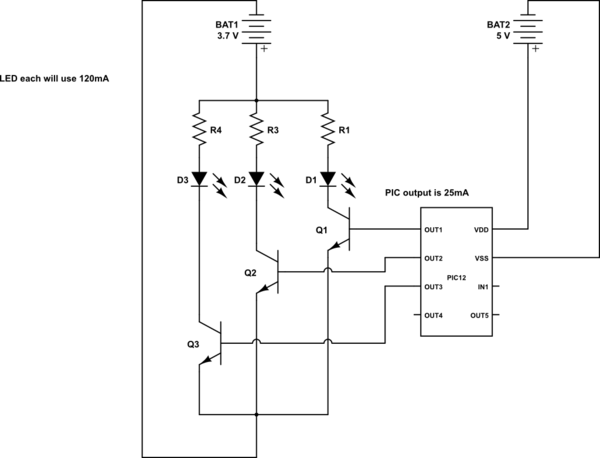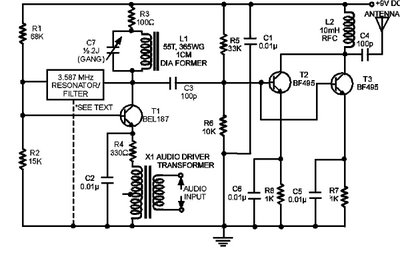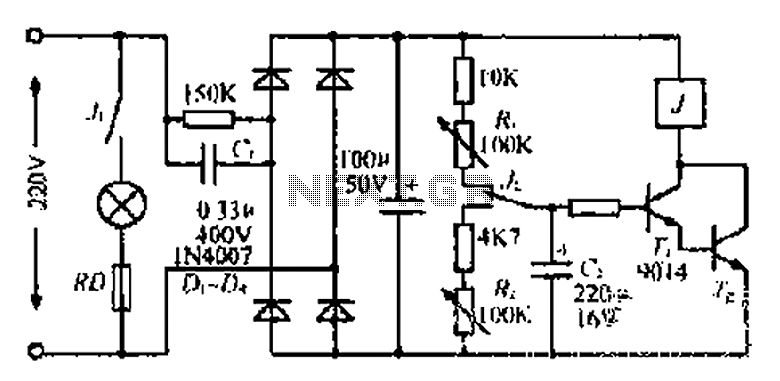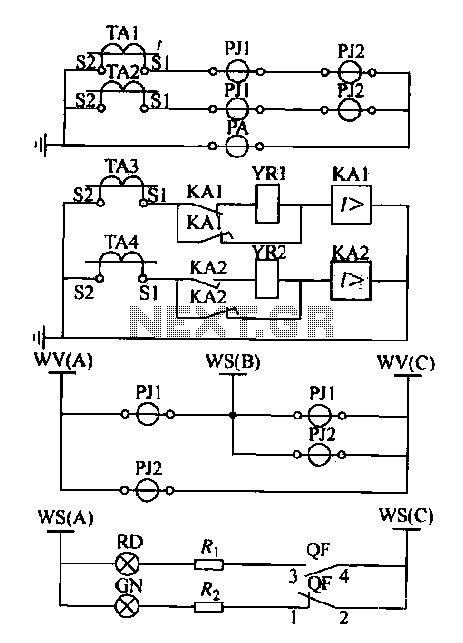
Class AB output circuit diode coupling
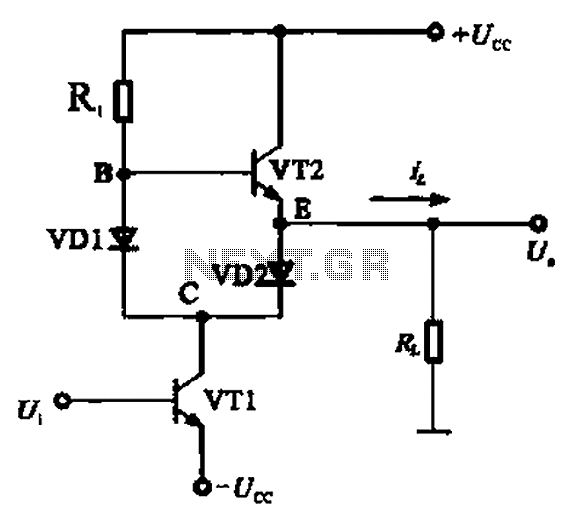
A Class AB output stage circuit is coupled with diodes, as illustrated in Figure 10-8. The static bias circuit for transistor VT1 (not shown) is adjusted so that the output at point E is at ground DC voltage UE. The forward voltage drops across diodes VD1 and VD2 are applied to the emitter of transistor VT2, allowing VT2 to operate in micro conducting Class AB mode. When the input signal U is in the positive half-cycle, the collector current of VT1 increases, which lowers the voltages at points B and C. This results in a decrease in the emitter voltage VI2 and subsequently turns off the voltage drop at point C, making VD2 fully conductive. Consequently, a current path is formed through RL, VD2, and VT1 to the negative supply voltage (-Ucc), allowing current to flow through RL, thus generating the output during the negative half-cycle. Due to the relationship RL and Rt, the collector signal current iCl is proportional to VT1/L. In the negative half-cycle of the input signal U, the collector current decreases, leading to an increase in the voltages at points B and C. This causes VT2 to conduct, and VD2 becomes connected to the positive supply voltage (+Ucc), allowing VT2 to create a positive half-cycle output signal. Therefore, VD2 acts as a gate, harmonizing the input signal voltage with the changes in the positive and negative half-cycles. In the actual circuit, VT1 and VT2 behave like all composite transistors.
The Class AB output stage circuit is designed to provide efficient amplification with reduced distortion. The configuration employs two transistors, VT1 and VT2, which work in tandem to manage the output signal across both positive and negative cycles. The biasing of VT1 is crucial as it sets the operating point, ensuring that the transistors are on the verge of conduction during idle conditions, thus minimizing crossover distortion.
The operation begins with the input signal U, which alternates between positive and negative cycles. During the positive half-cycle, the increase in collector current for VT1 reduces the voltage at points B and C, allowing for the emitter voltage to drop. The forward biasing of VD2 enables it to conduct fully, creating a path for the current to flow through the load resistor RL. This flow generates the output signal in the negative half-cycle.
Conversely, during the negative half-cycle, the collector current of VT1 decreases, which increases the voltages at points B and C. This condition turns on VT2, allowing it to conduct and connect VD2 to the positive supply voltage. This action creates a path for the output signal during the positive half-cycle, effectively mirroring the input signal's variations.
The use of diodes VD1 and VD2 plays a significant role in controlling the conduction states of the transistors. These diodes ensure that the transistors operate efficiently within their linear region, contributing to the overall performance of the amplifier. The careful design of the circuit, including the selection of resistor values and the configuration of the biasing network, is essential for achieving optimal performance and minimizing distortion in the output signal. Class AB output stage circuit coupled diode shown in Figure 10-8. Static, adjust VT1 bias circuit (not shown), so that the output at point E on the ground DC voltage UE o. The forward voltage drop VD1 applied to the emitter of VT2 and VD2, make VT2 in micro conducting class AB operation. When the input signal U is positive half weeks. VT1 collector current increases, B and C point point-to-ground voltages are lowered. Point B so that the voltage drop emitter voltage VI2 and drop off, C point voltage drop makes VD2 fully on.
then. RL, VD2, VT1 and - Ucc formed through path, the current flowing through RL Tuen bottom-up forms the output of the negative half cycle. Because RL Rt, so the collector signal current iCl- VT1/L. When the input signal U is negative half-cycle,/c decreases, B and C point voltage is increased. Thus, VT2 conduction and VD2 end, + Ucc, VT2 and shame to form a positive half cycle of the output signal.
Thus, VD2 corresponds to a gate, gate open harmony by the input signal voltage of positive and negative half-cycle of a change in control. In the actual circuit. VT1 and VT2 - like all composite pipe.
The Class AB output stage circuit is designed to provide efficient amplification with reduced distortion. The configuration employs two transistors, VT1 and VT2, which work in tandem to manage the output signal across both positive and negative cycles. The biasing of VT1 is crucial as it sets the operating point, ensuring that the transistors are on the verge of conduction during idle conditions, thus minimizing crossover distortion.
The operation begins with the input signal U, which alternates between positive and negative cycles. During the positive half-cycle, the increase in collector current for VT1 reduces the voltage at points B and C, allowing for the emitter voltage to drop. The forward biasing of VD2 enables it to conduct fully, creating a path for the current to flow through the load resistor RL. This flow generates the output signal in the negative half-cycle.
Conversely, during the negative half-cycle, the collector current of VT1 decreases, which increases the voltages at points B and C. This condition turns on VT2, allowing it to conduct and connect VD2 to the positive supply voltage. This action creates a path for the output signal during the positive half-cycle, effectively mirroring the input signal's variations.
The use of diodes VD1 and VD2 plays a significant role in controlling the conduction states of the transistors. These diodes ensure that the transistors operate efficiently within their linear region, contributing to the overall performance of the amplifier. The careful design of the circuit, including the selection of resistor values and the configuration of the biasing network, is essential for achieving optimal performance and minimizing distortion in the output signal. Class AB output stage circuit coupled diode shown in Figure 10-8. Static, adjust VT1 bias circuit (not shown), so that the output at point E on the ground DC voltage UE o. The forward voltage drop VD1 applied to the emitter of VT2 and VD2, make VT2 in micro conducting class AB operation. When the input signal U is positive half weeks. VT1 collector current increases, B and C point point-to-ground voltages are lowered. Point B so that the voltage drop emitter voltage VI2 and drop off, C point voltage drop makes VD2 fully on.
then. RL, VD2, VT1 and - Ucc formed through path, the current flowing through RL Tuen bottom-up forms the output of the negative half cycle. Because RL Rt, so the collector signal current iCl- VT1/L. When the input signal U is negative half-cycle,/c decreases, B and C point voltage is increased. Thus, VT2 conduction and VD2 end, + Ucc, VT2 and shame to form a positive half cycle of the output signal.
Thus, VD2 corresponds to a gate, gate open harmony by the input signal voltage of positive and negative half-cycle of a change in control. In the actual circuit. VT1 and VT2 - like all composite pipe.
